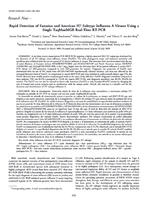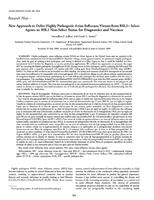Browse Items: 3
Rapid Detection of Eurasian and American H7 Subtype Influenza A Viruses Using a Single TaqManMGB Real-Time RT-PCR
A real-time reverse transcription PCR (RRT-PCR) targeting a highly conserved HA2 H7 region was developed for the detection of all H7 subtype avian influenza viruses (PanH7). The wide phylogenetic scope and analytical sensitivity and specificity were validated with the use of a panel of 56 diverse influenza A viruses. The detection limit was…
New Approach to Delist Highly Pathogenic Avian Influenza Viruses from BSL3+ Select Agents to BSL2 Non-Select Status for Diagnostics and Vaccines
Highly pathogenic avian influenza viruses (AIVs) are Select Agents in the United States and are required to be handled in bio-containment level-3 enhanced (BSL3+) facilities. Using a reverse genetics system, we attenuated a highly pathogenic virus, with the goal of making it low pathogenic and having it delisted as a Select Agent so that it could…
Biologic Characterization of Chicken-Derived H6N2 Low Pathogenic Avian Influenza Viruses in Chickens and Ducks
Low pathogenic avian influenza H6N2 viruses were biologically characterized by infecting chickens and ducks in order to compare adaptation of these viruses in these species. We examined the clinical signs, virus shedding, and immune response to infection in 4-wk-old white leghorn chickens and in 2-wk-old Pekin ducks. Five H6N2 viruses isolated…
 An official website of the United States government.
An official website of the United States government.




